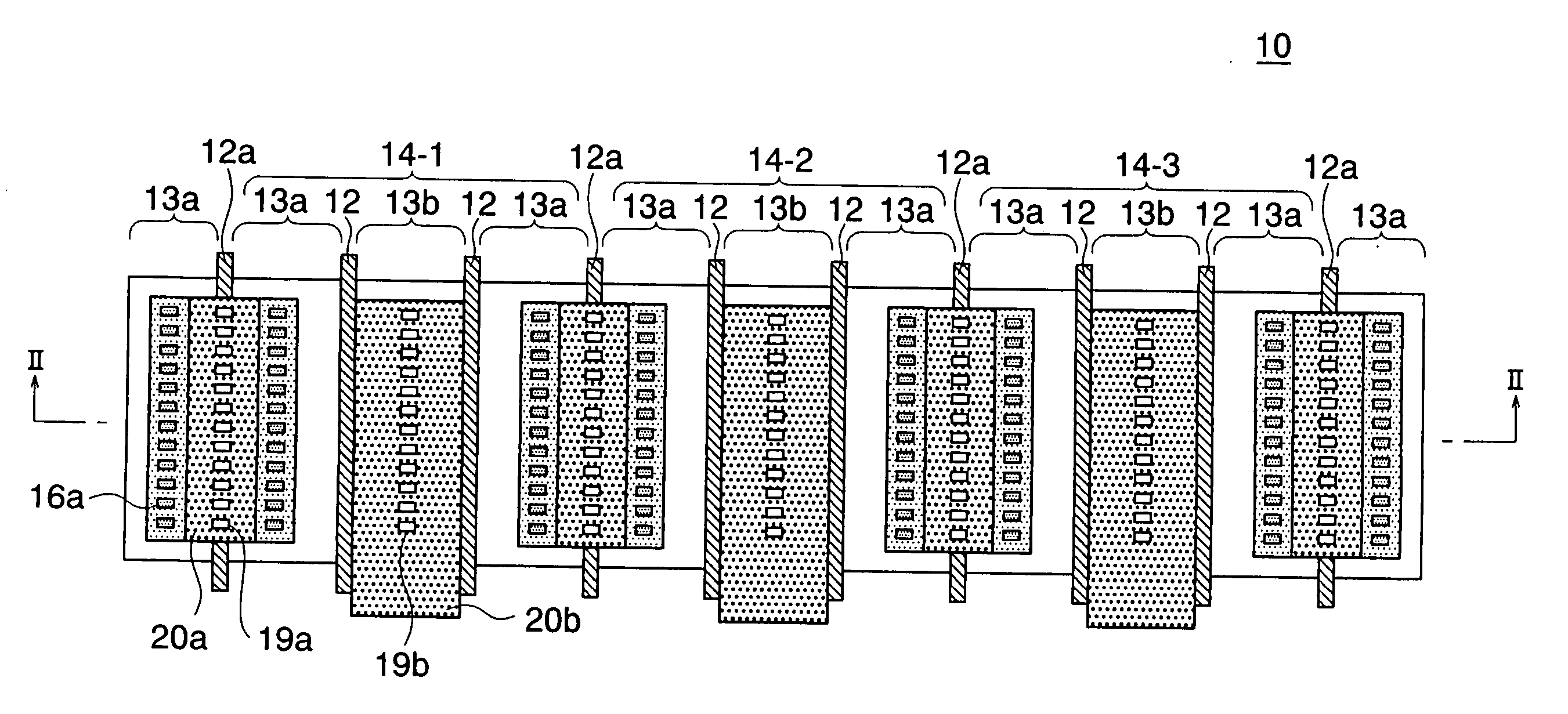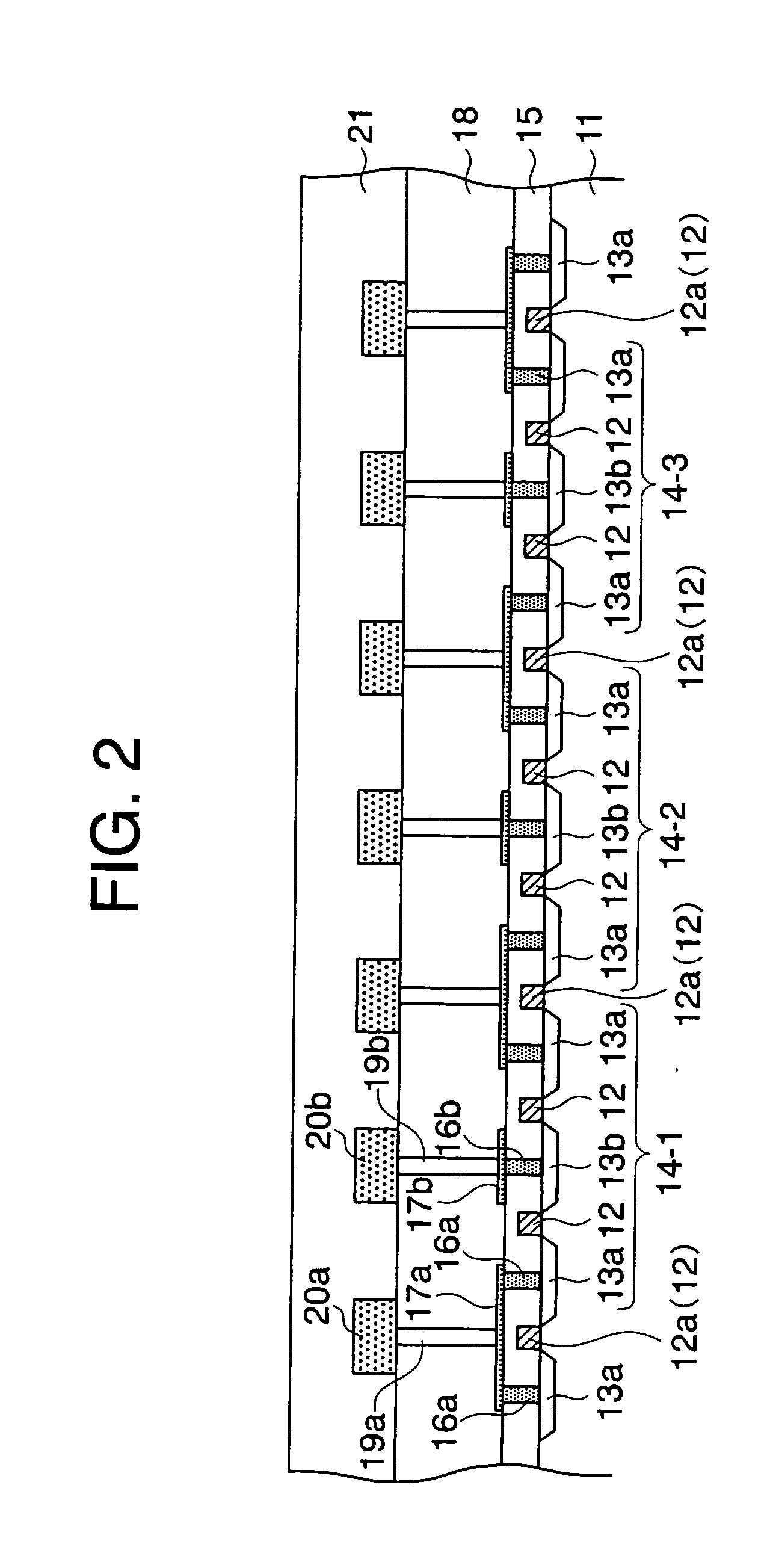Semiconductor device having a dummy gate
a technology of dummy gate and semiconductor device, which is applied in the direction of semiconductor device, semiconductor/solid-state device details, electrical apparatus, etc., can solve the problems of reducing the design rule, the parasitic capacitance between the conductive layer and the interconnect, and the inability to achieve the desired operational speed, etc., to achieve the effect of increasing the flexibility of the arrangement, and increasing the regularity
- Summary
- Abstract
- Description
- Claims
- Application Information
AI Technical Summary
Benefits of technology
Problems solved by technology
Method used
Image
Examples
first embodiment
[0051] The present invention will be now described below in further detail with reference to the accompanying drawings. FIG. 1 is a top plan view of a semiconductor device according to the present invention. FIG. 2 is a sectional view taken along line II-II in FIG. 1. In FIG. 2, reference numerals used in the conventional semiconductor device 70 shown in FIGS. 9 and 10 denote the components which are common to the conventional one. Similarly to the semiconductor device 70 shown in FIG. 9, the semiconductor device, generally designated by numeral 10, includes PMOS transistors in the CMOS gates of the ring oscillator 60 such as shown in FIG. 8.
[0052] In the semiconductor device 10, the diffused regions 13 are arranged, starting from a first edge of the semiconductor device 10, in the order of source (source region) 13a, source 13a, drain (drain region)13b, source 13a, source 13a, drain 13b, . . . , drain 13b, source 13a and source 13a, which is disposed at a second edge of the semicon...
second embodiment
[0061]FIG. 4 is a top plan view of a semiconductor device according to the present invention. The semiconductor device, generally designated by numeral 30, includes therein a ring oscillator such as shown in FIG. 8, which includes a PMOS section 31 configured as by the portion of the semiconductor device 10 shown in FIG. 1 and an NMOS section 32 including nMOS transistors 14-1, 14-2, and 14-3 and configured as NMOS transistors. The PMOS section 31 and NMOS section 32 are arranged in parallel to each other in the lengthwise direction, with the pMOS transistors 14-1 to 14-3 of PMOS section 31 and the respective nMOS transistors 14-1 to 14-3 of NMOS section 32 opposing each other.
[0062] The second-layer drain line 20b of the PMOS section 31 extends toward the NMOS section 32 to be connected to the second-layer drain line 20b of the NMOS section 32. Pairs of gate electrodes 12 formed in the pMOS transistors 14-1 to 14-3 of the PMOS section 31 are connected to the counterparts of the NMO...
third embodiment
[0067]FIG. 6 is a top plan view of a semiconductor device according to the present invention. The semiconductor device, generally designated by numeral 40, is similar to the semiconductor device 10 of FIG. 1 except that the second-layer drain line 20b is formed only in the portion in the vicinity of the nMOS section. In the semiconductor device 40 of the present embodiment, the length of the portion in which the second-layer drain line 20b and the second-layer source line 20a extend parallel to each other or the length of the overlapping portion between the second-layer drain line 20b and the first-layer drain line 17b disposed below the second-layer drain line 20b or the underlying drain region 13b is reduced, thereby reducing the parasitic capacitance between them.
PUM
 Login to View More
Login to View More Abstract
Description
Claims
Application Information
 Login to View More
Login to View More - R&D
- Intellectual Property
- Life Sciences
- Materials
- Tech Scout
- Unparalleled Data Quality
- Higher Quality Content
- 60% Fewer Hallucinations
Browse by: Latest US Patents, China's latest patents, Technical Efficacy Thesaurus, Application Domain, Technology Topic, Popular Technical Reports.
© 2025 PatSnap. All rights reserved.Legal|Privacy policy|Modern Slavery Act Transparency Statement|Sitemap|About US| Contact US: help@patsnap.com



